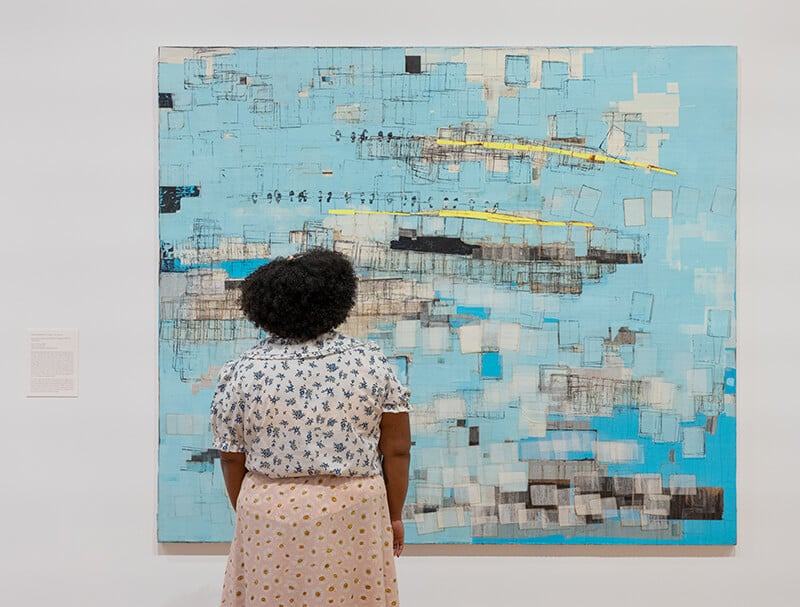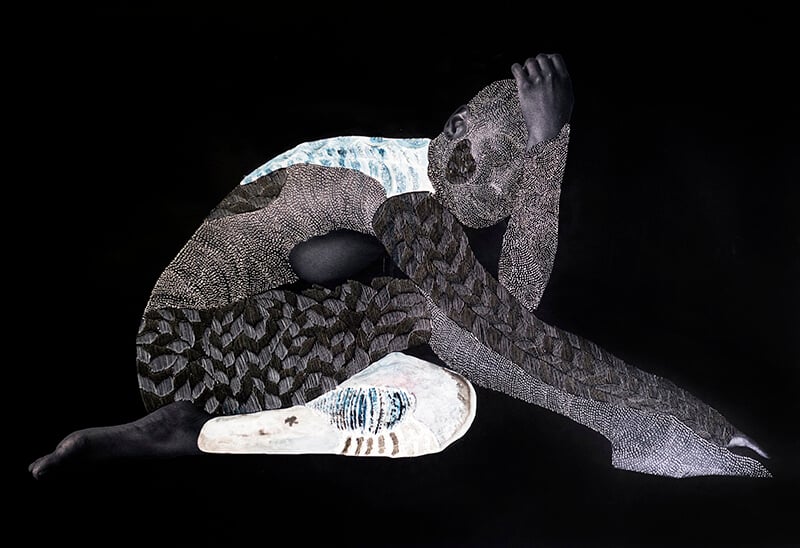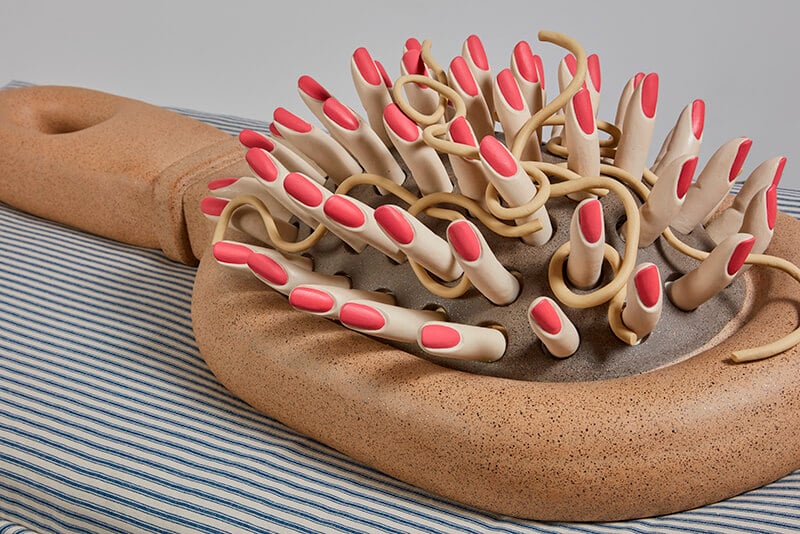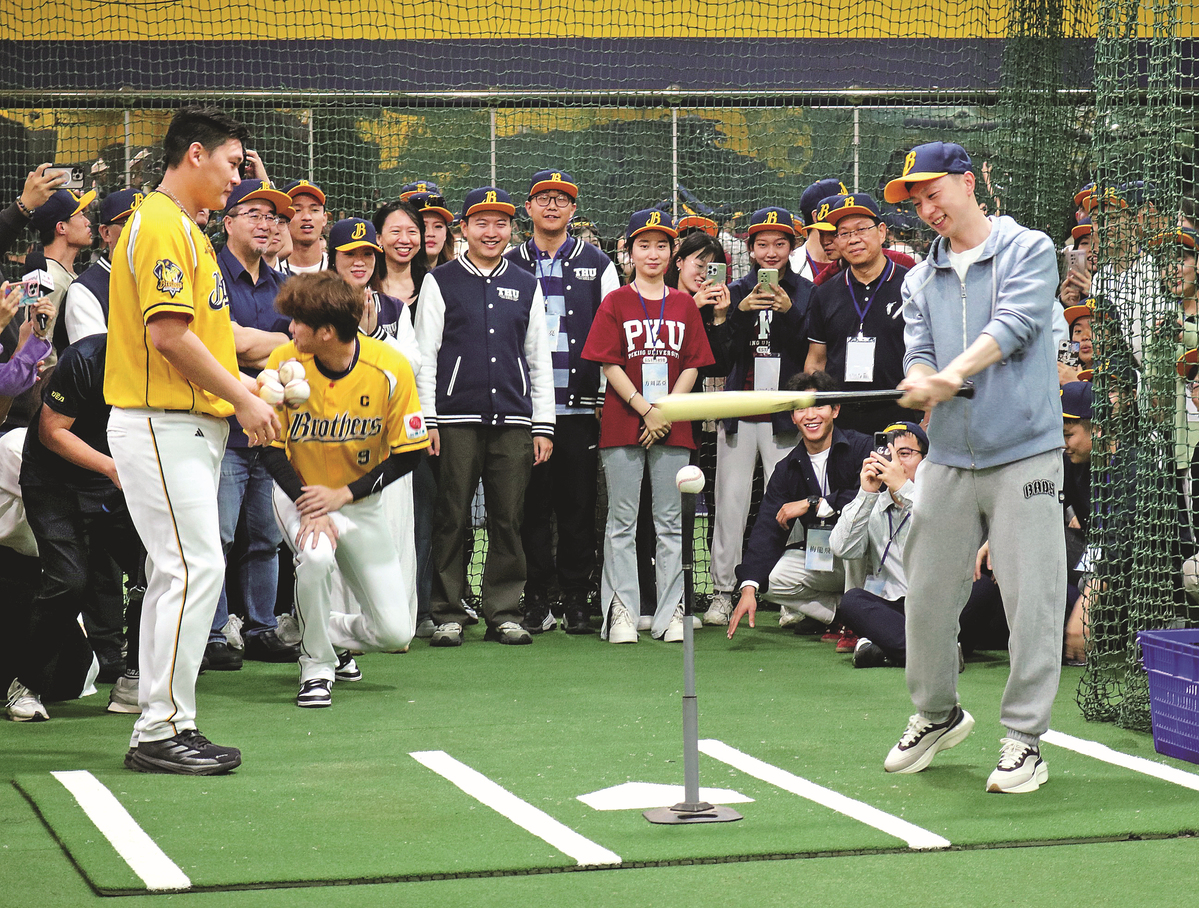The Art of Work
Can a day job be more than an energy suck? Visitor viewing Mark Bradford, Same ‘Ol Pimp(2002), Collection ofBarbara and Michael Gamson.
Visitor viewing Mark Bradford, Same ‘Ol Pimp(2002), Collection ofBarbara and Michael Gamson. o
r
d
F
a
c
t
o
r
y
Day Jobs. Blanton Museum of Art, University of Texas at Austin, February 19, 2023–July 23, 2023.
The tour of Day Jobs, an exhibition at the Blanton Museum of Art at the University of Texas at Austin, was scheduled for 2 p.m. I had taken the day off work so I could attend it, and I had the morning to spend how I wanted.
The first thing I did was open my work computer. I was thinking of a comment I’d left the night before for someone in another department; worried it might come off as annoying, I went back and edited it. Then I saw a couple of notifications and clicked over to read the messages. By the time I closed my computer, I’d worked for more than an hour.
I could have, and should have, chosen not to. But unlike friends who profess to empty their heads of work when they’re not there, I have never succeeded at stopping my jobs from coloring everything around me. Even when I have wanted to quit, even when I have known my energies would be better spent elsewhere, even when I have thought the world would improve if my employer’s business model disappeared—even then my brain has been pocked with occupational worries. They usually have to do with writing in the voice of an institution, something I chose out of a conviction that I would never be able to pay the bills with journalism, scholarship, publishing—any kind of writing I might do under my own name. Now I pay the bills just fine, but it’s cost me a big chunk of my mind.
I have never succeeded at stopping my jobs from coloring everything around me.
Or so I like to say. Day Jobsmakes the countersuggestion that, for people with creative ambitions, day jobs should be recorded not as losses but as gains. Frank Stella, after all, repurposed paint from his house-painting jobs. Howardena Pindell puts office detritus, like hole-punch clippings, on her canvases. Julia Scher has installed surveillance systems as art, and also for real. Gathering works by these artists and thirty-five others, the exhibition at the Blanton Museum proposes that the day job has been a generative force in U.S. art, inspiring artists’ techniques, concepts, and materials over the past seventy years.
“Every American artist has a day job,” Veronica Roberts, the curator,[*] estimated early in the tour. But it is a smaller group whose day jobs “had a real influence on their practice and shaped their work in some pivotal way.” By focusing on this influence, Roberts hopes to valorize less rarefied sources of artistic inspiration. In her view, art people are generally happy to discuss aesthetic lineage—“you know, that they were inspired by Jackson Pollock”—but less willing to foreground workaday source material. “Why,” Roberts asked, “aren’t we learning about the way that artists’ true lived experiences are shaping their artwork?”
One answer is that artists don’t want us to: Ragen Moss, two of whose pieces appear in the show, was “really reluctant to tell anyone that she was still a practicing attorney for fear that they would think she was less serious” as an artist. Another answer is that we often dohear stories of on-the-job inspiration: many of those the exhibition references also appear in years-old press coverage. The main contribution of Day Jobsis not novelty but gathering all this art grown out of work so that it can be seen as a collective phenomenon.

“Caregivers,” one of the show’s six industry-themed sections, most fully realizes this project. It begins with Nate Lewis, who started his art practice while working as an ICU nurse. He made his earliest pieces with paper strips on which patients’ heart rhythms were printed for evaluation. “There was nothing else I wanted to do than make work with patients’ heart rhythms,” Lewis said in an interview excerpted on the museum’s website. “I thought, this is the pinnacle for me.” But the strips were not of archival quality, so he turned to other media. In both Signaling XXIII(2020) and Signaling XVI(2019), a photographic image of a single person is printed in black against a black background. Contrasting patterns are made with an X-Acto knife or graphite. Broken chevrons rope muscle-like along a thigh; a stippled motif, like pores caught on X-ray, covers a face. These patterns draw the figures forth from the monochrome, bringing to the surface the varied rhythms that course through each human being.
Lenka Clayton makes art tuned to a different intimate frequency. Her job is listed as founder of An Artist Residency in Motherhood (2012–ongoing), a conceptual exercise in which she secured grant funding to stay home and parent. She wanted to frame motherhood “as a site to work in and with,” she says in a quotation on one of the Blanton’s museum labels. In 63 Objects Taken Out of My Son’s Mouth(2011–2012), the tiny objects are lined up under glass, in seven rows of nine each, ordered by color to create a pleasing spectrum. You can see her son’s predilections—rocks, money, buttons—and imagine the situations that led to his more novel selections: a metro ticket, a cigarette butt, a used teabag. By meticulously aestheticizing years of quotidian vigilance, and compressing the patterns she noticed so that people other than her could see them, Clayton—like Lewis—draws a parallel between the attention required of any caregiver and the attention required of any artist. They are different sides of the kind of coin she might flip out of her son’s mouth and onto a dais.
Rounding out the section are two nannies. Vivian Maier (1926–2009) was posthumously found to be a gifted photographer of everyday detail: the shadow of a hat, edging along a path toward an abandoned women’s shoe, behind which two tiny feet dangle from a stroller; a man with a contemplative expression, sitting just around the bend from two people walking tensely. These scenes, and her seven others on display, catch poignant or funny contrasts that would have disappeared moments later. Jay Lynn Gomez is more focused on what is overlooked but persistent. Working for a family in Beverly Hills, she began to paint workers without faces into scenes from luxury magazines. In her Self-Portrait(2013), done on a Luxe Interiors + Design cover, two blond babies hang off a brown caretaker in a photograph of a spacious, immaculate garden. Like her other painted workers, shown facelessly enabling lifestyles that aren’t theirs, she simultaneously stands out and blends in.
“Caregivers” traces the slippage of caring attention between the aesthetic and the social. It roots the art in everyday life, enshrining—and then questioning the conditions of—the care both grew from. The artists featured in “Fashion and Design” and even more so “Media and Advertising” are unsurprisingly more apt to play with surfaces. The most famous are Barbara Kruger and Andy Warhol (1928–1987), both known for making art that holds a mirror to the commercial imagery they also produced—Warhol’s mirror straight, Kruger’s purposefully distorted. Genesis Belanger worked more behind the scenes, staging advertisements as a prop stylist’s assistant. Her installations now beckon with ad-like insistence, but add twists that belie their own appeal. In Big Sleep(2019), a huge hairbrush resting on a mattress looks pristine, but its bristles are women’s fingers. The works in these sections build on one another to suggest a trend: involvement in the production of consumer culture makes artists particularly adept at manipulating and repurposing it—and the tactics used to create it—for their own wily ends.

But the most interesting “Media” and “Design” pieces are outliers: Marsha Cottrell’s nine abstract patternscapes, made between 1997 and 2021, are subtle and luxurious. Made of laser toner on paper and mylar, they are the result of experiments that began with an office printer. In one, a light orb and a dark orb eclipse each other’s edges. In another, white dots fall like stars against a wall of ink. Lent a mystical aspect by their astronomical references, these pieces look like portals to another world, in which a site of drudgery can become a site of beauty with a little patience and experimentation.
Mark Bradford does something similar with end papers for perms, which he discovered while working at his mom’s beauty shop. A few scattered on the floor one day and “caught the light in such a way,” Roberts explained, that Bradford saw their aesthetic potential. More than twenty years later, he’s known for paintings in which the translucent rectangles are carefully arranged to add layers of structure, texturing the color. In Same ‘Ol Pimp(2002), one of his two works in the show, tiny birds alight in blue abstraction on wiry lines sketched by the papers’ edges. Like Cottrell, Bradford found a way to repurpose not just his work product but its raw material, enacting a more profound transformation.
Large sections of the exhibition—“Service Industry”; “Finance, Technology, and Law”—serve more to emphasize the diversity of artists on display than to draw connections among them. What does a restaurant server have in common with an installer of security systems? What does a commodities broker have in common with a public defender? Collectively, these jobs are well-paid and less so, stimulating and dreary, morally fraught and as harmless as jobs can be. Grouping them so broadly generalizes their specific qualities, neutralizing seemingly incommensurate differences in the ways they might influence an artist’s vision. The artworks extend in so many directions that, walking through them, my attention came to rest at the most generic level of similarity: here were a bunch of exceptional individuals. More specifically, here were seductively narrow spotlights beamed on inflection point after inflection point at which a creative mind had turned this valuable material, a job, into art. So many spotlights make a halo, or maybe a mirage. I wanted a job, too, until I remembered I already had one.
Paid Time Offor Reasonable Hoursor Decent Working Conditionsmight have been just as apt an exhibition title.
In the end, the art in Day Jobsis not demystified by its source material as much as the day jobs are remystified by artistic success. The only way for this effect not to have occurred might have been to show unfinished, unrealized, or nonexistent art: what artists couldn’t quite bring to completion, or couldn’t even start, because they were too busy with, or tired from, their jobs. But no one wants to see that, no matter how much more representative it might be. “I actually think we’re at a real crisis point in some ways in how much people have to work right now to just support themselves,” Roberts said in an interview. “It takes a certain bravery and patience and hard work to take the day job and have it turn into something that really is remarkable art.”
The artist interviews posted on the Blanton’s website and quoted on museum labels hint at another important ingredient. “The beautiful thing about it,” Lewis said of nursing, “is that, you know, intensive care—it’s only three days a week. . . . Which is really amazing. And a lot of that [free time] was dedicated to starting to draw.” Robert Mangold, one of several artists in the “Art World” section who worked at the Museum of Modern Art in the mid-twentieth century, explained that, “It was reasonable pay. And you got health insurance, and you didn’t start until—I think the museum maybe opened at 11 a.m. and closed at 5 p.m.” Other artists are described as having been part-time, or freelance. Excepting a few jobs that are explicitly presented as draining, Paid Time Offor Reasonable Hoursor Decent Working Conditionsmight have been just as apt an exhibition title.
Of course, an art exhibition, no matter how collectively minded, will not be the thing to make these conditions general. It will be the concerted effort of millions of people, some of whom are currently busy organizing unions or otherwise trying to improve workers’ lives—including on the very campus where the Blanton Museum sits. This work, though, is not in the purview of a show with the goals of Day Jobs. And all I have to offer is my own meager data point. In 2019, wanting to shrink the place of work in my life, I took a job that was only four days a week. My preoccupation with work did not disappear, but it diminished disproportionally. With 20 percent less time on the job, I wrote at least 200 percent more than I had before. Ten or so pieces a year, for example, instead of none to a few. Last February, for reasons not interesting enough to detail here, I left for a full-time job elsewhere. I was confident that I could keep the momentum going. It was ten months, though, before I pitched a single essay—this one.
[*] Roberts is no longer a curator at the Blanton. She recently left to take a new job as the director of the Cantor Arts Center at Stanford University.



















